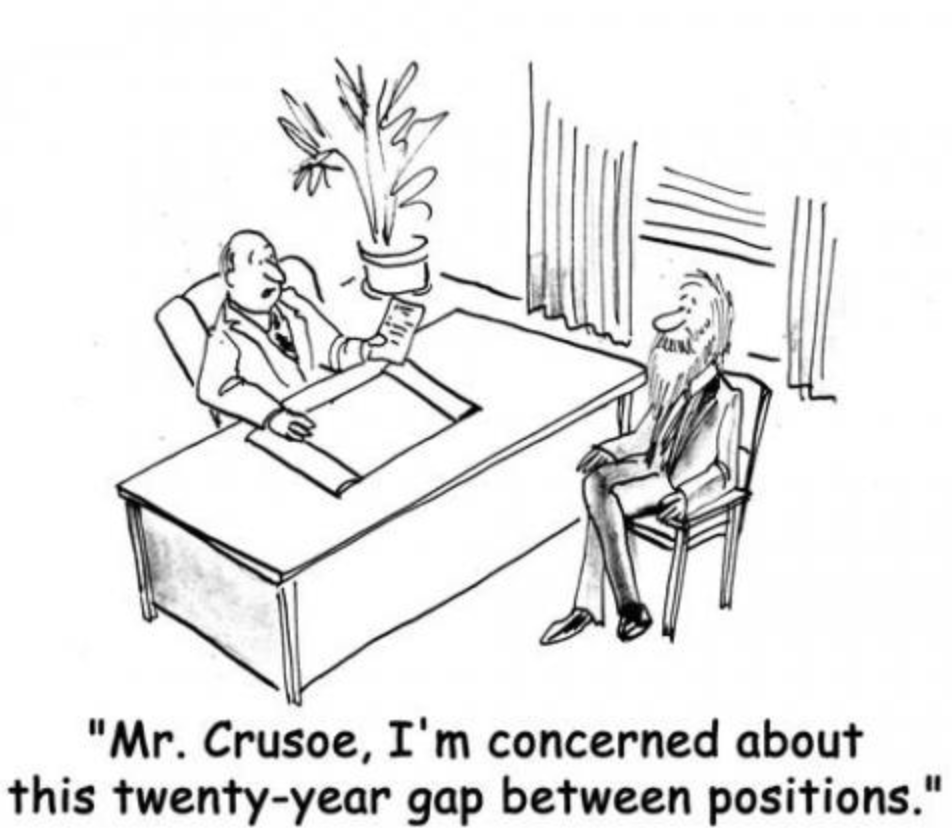;)
How to Handle Employment Gaps on Your Resume
| September 17, 2019| Job SeekerIf you have gaps in your job history, you’re not alone. Most people have been unemployed at some point in their career, so this situation is more common than you may think.

The truth is, employers understand that life happens and there could be endless reasons for time off in between jobs. Maybe you were a caregiver with a new child or an aging parent. Or perhaps you were fighting an illness or injury and needed a break from the workforce. You might have decided to travel or return to school. And even if you were terminated or you had to resign, those things can happen, too. What’s important to understand is that a gap in your resume doesn’t mean a gap in your ability and value. This is what you should convey to prospective employers.
Here are some things you can do to handle gaps in a way that will showcase your very best:
1. Use your cover letter to address gaps. Your cover letter is a great way to share things about yourself, which a resume wouldn’t necessarily do. This could include a job anecdote, some meaningful and relevant life experience and yes, gaps in your employment history. It’s the perfect place to address your job situation head on, with a reasonable and concise explanation why you were temporarily out of the workforce. If possible, you can add important things you were doing to stay sharp, focused and in touch with your industry during this time, such as classes, training, consulting and temporary work. This way, the person reviewing your resume won’t be left wondering. Rather, they will have the details and context from you directly. And it shows that you aren’t afraid to acknowledge it, thereby making it a nonissue in terms of the good things you bring to the table.
2. Be confident, honest and accentuate the positive. Since gaps in your job history are common, there’s no reason to be nervous when addressing this with a potential employer. Instead, show confidence and certainty when explaining the reasons behind it. Convey that there was a perfectly reasonable reason, without excuses or hesitation. Things happen in life, and employers understand this. And if the hiring manager is a bit unsure, you have an opportunity to correct this with your confidence. In fact, rather than downplay or try to gloss over any employment gaps, be direct. Show them whatever you did was because of a great need, a significant situation, life change or an unavoidable responsibility. People will respect reasons, such as caring for an ailing parent, going back to school and being laid off. Don’t feel like you have to justify anything. Instead talk about how you handled yourself, the things you did during your time off to stay ready for the workplace and how motivated and eager you are to get right back to work!
3. Fill current (or future) employment gaps with good experiences. If you’ve had a gap or if one should happen, what you’ve done during this time is what matters.:
If you currently have a job gap on your resume, remember the things you did during that time. Think about what you did to fill your time, which will show off your strengths and character. For example, maybe you coached a youth sports, mentored peers, volunteered for a cause or organization or were involved with your community or local schools in some way.
If you’re currently in between jobs, plan a number of things you can do right now to stay up to speed in your career. Temporary, contract and consulting work are great ways to show job continuity and employment activity. Show that you’re connected with the workplace, are honing your skills and making a difference in an organization. You can also take classes/training to improve your skills and experience, write a blog, attend industry conferences, events and networking opportunities. Stay active and in touch with the business community so that you’re ready to transition back to a permanent role when the time comes.
4. Use a functional resume format. If you really don’t want to address gaps in your employment, use a different resume format. You don’t have to include each and every bit of experience, and list only the jobs you think will highlight your strengths for the position you are applying for. Begin the resume with a summary of your qualifications.

To help you prepare your cover letter and prep for interviews, following are sample responses to different kinds of scenarios for employment gaps. As these are just ideas to get you started, you can tailor them to your unique situation and, of course, craft your own explanations.
If you’ve been out of work a long time.
“I didn’t expect to be without a job for this long, and I’m making every effort to get back to work permanently. Even though job hunting has changed, with more ways and places to find work, I am doing everything I can to land a new opportunity. In the meantime, I’ve been volunteering at my local library, which gives me time and resources to job hunt and work on a new blog I started about marketing. I have also been temping at a few different companies to stay sharp and earn money. I am very determined to get back to work and be part of a great team. ”
Layoff
“While I was successful at my previous employer, unfortunately the company was forced to downsize, and my position was eliminated. Even though they offered to be a reference and help me find new work, it was really a difficult time for me. But I’m confident that I have a lot of positives to take away from my time there. The relationships I built, along with the skills and experience I developed, will definitely help me bring even more value to my next job.”
Fired
“After a promising start with good intentions from everyone, the company and I seemed to have different expectations of my role and what they needed. It just wasn’t the right fit, which we eventually realized. But I left on good terms, understanding that not every position is for everyone. Sometimes things happen. Still, I did learn a lot about myself and I take that experience as an opportunity to grow and improve. I’m really excited and motivated to carry this into my next role.”
Left to be a Caregiver
“It came to a point where I had to put family first and become a main caregiver. My employer was very understanding, even while I was working, and appreciated my need to balance my job and family. But eventually I had to be home. During that time I was able to keep up to speed on my industry and stay in touch with colleagues, so that I would return to work with the right mindset and focus. There was never any question about my wanting to return to work, and now I’m 100% able to commit to a full time job.”
Back to School
“At some point I realized that I had some gaps in my knowledge and felt that returning to school to build a stronger foundation for my career was really important. It wasn’t easy leaving work, but I knew in the long run that returning to school and getting extra training would strengthen my value and help me contribute even more to my next job. I’m more confident, prepared and ready to get back to work.”
Whatever your reason for leaving a job, there is always a way to explain it to potential employers in a positive way. As long as you are confident, honest and show commitment to getting back to work with the right attitude, they will respect and understand your situation. Show them that regardless of the reason, you learned from your experience, you proactively looked for work and stayed active in the workplace through temping or some other way. Employers want to know that you’ve kept busy in any manner that helped your community by volunteering, improved your experience and skill set by learning and that you’ve kept your mind sharp by writing, attending industry events or even doing project work where you can.
With the right approach, you can successfully handle employment gaps. Even more, being proactive via a cover letter or during the interview can set the tone right away with recruiters. It will help you control the conversation and focus on what really matters–your strengths and determination to get back to work! Let companies know that now is the time and you’re 100% ready to be there for them!
